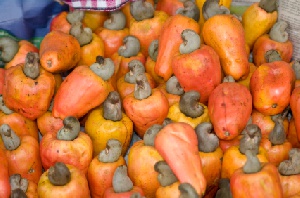Exports of non-traditional products from January to December 2015 amounted to US$2.522billion or GH?9.210billion, representing an increase of 0.32% over the year 2014, the Ghana Export Promotion Authority (GEPA) has announced.
The figure represents just over half of a five-year, US$5billion target set in 2013 under the National Export Strategy.
Released yesterday, the statistics indicate that the marginal increase in revenue from US$2.514 billion in 2014 to US$2.522b in 2015, was mainly due to increase in agricultural products exports, particularly cashew nuts.
Total earnings of the sector stem from three sub-sectors – agriculture, handicraft, and processed and semi-processed products like canned tuna, cocoa paste, shea oil, among others.
Although the processed and semi-processed products sub-sector contributed the most to total revenue (84.09%), its contribution of US$2,120.50 million represents a 2.27percent decline over the year 2014 figure of US$2,169.65million.
This, GEPA said, is due to a decline in the performance of some key products such as cocoa paste, natural rubber sheets and aluminium plates, sheets and coils.
Earnings from the agriculture sub-sector amounted to US396.91million compared to US340.68million in 2014, an increase of 16.51percent. The sub-sector contributed 15.74 percent to total earnings.
The growth was driven by products like shea nuts, banana, pineapple, yams, mangoes and palm nuts and kennel.
The handicrafts sub-sector, on its part, raked in US$4.27million, which is a 23.05 percent increase from the US$3.47million realised in 2014. Its contribution to total earnings of non-traditional exports increased from 0.14 in 2014 to 0.17 in the year under review.
Batik and Tye and Dye, which falls under the handicraft sub-sector, contributed the highest volume of revenue in the sector of US$1 million in 2015, compared to US$285,495 in 2014, representing a 381.58% increase.
Largely, the European Union has been listed as the highest consumer of Ghana’s NTEs, followed by ECOWAS countries, with 35.84% and 31.59% respectively of the total volumes of products exported. The country generated US$903,777,987 on exports of non-traditional products to the EU in 2015, and US$796,686,571 to ECOWAS countries.
Commenting on the statistics, Board Chairman of GEPA, Kobina Ade-Coker, said: “The European Union is one of our major markets so it is very important that we concentrate on that market. But notwithstanding that, we should also concentrate on the ECOWAS Region because that is even closer to us and the more we are able to export to the ECOWAS Region, the more we take advantage of the Africa or intra sub-region trade”.
Meanwhile, together with other stakeholders, GIPA is adopting several strategies, including focusing on the services export area, to draw in extra revenue to meet the 5year target.
Chief Executive Officer of GEPA, James Tiigah, said: “The other key area we are looking at is the services area. We realise that we are getting good hospitals, we are getting good educational institutes, and so we want to encourage medical tourism, and education so that people will come from the sub-region and study in our universities.
We are sure there are more than ten thousand foreign students in Ghana pursuing different courses, and if we are able to identify them, and sell that service, we should be earning a lot.”
In order to achieve the US$5billion target, eleven priority product sectors were identified and recommended for “aggressive” support. These include cocoa products, cashew nuts, horticultural products, fish shea nuts and gold jewelry.
Business News of Friday, 2 September 2016
Source: B&FT
Non-traditional exports see marginal growth
Entertainment
















